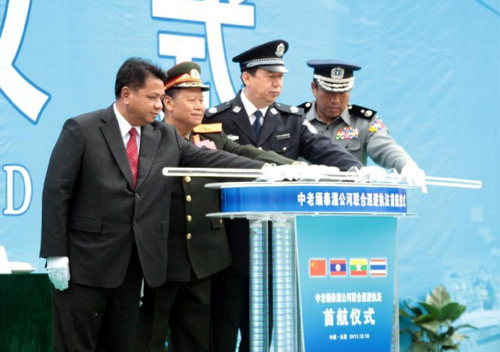
Mekong River Patrols in Full Swing but Challenges Remain
Publication: China Brief Volume: 12 Issue: 4
By:

Following the brutal murder of 13 Chinese sailors on the Mekong River in October 2011, China prevailed upon Thailand, Burma and Laos to improve transboundary law enforcement cooperation by participating in coordinated riverine patrols launched in December. While China’s participation in coordinated patrols in Southeast Asia is not unprecedented—the Chinese and Vietnamese navies have been conducting regular patrols in the Gulf of Tonkin since 2006―the Mekong initiative is another indication of Beijing’s growing influence in the region and its willingness to utilize its security forces to protect Chinese economic interests and citizens abroad.
The Mekong Murders
The circumstances surrounding the killings are still murky and many questions remain unanswered. It appears, however, that two Chinese cargo vessels—the Hua Ping and Yu Xing 8―were hijacked on October 5 near the Thai port of Chiang Saen in the northern province of Chiang Rai. Several days later Thai security forces found the bodies of 13 Chinese crew members on board the vessels or floating nearby: most had been bound and blindfolded before being shot or stabbed to death. The Thais recovered nearly one million methamphetamine tablets on the vessels with an estimated street value of 100 million baht ($3.2 million) (Associated Press, October 14, 2011).
The Thai authorities initially pointed the finger of blame at drug warlord Nor Kham, an ethnic Shan whom they accuse of illegal narcotics trafficking, kidnapping and running protection rackets along the Mekong between Chiang Saen and Guanlei in Yunnan Province. In late October, however, the story took a new twist when nine Thai soldiers belonging to an anti-narcotics task force of the Third Army (responsible for security in northern Thailand) were detained and charged with the murders of the Chinese sailors. Observers speculated that the Thai soldiers were in the pay of a local drugs baron and/or that they had demanded protection money from the crew. The Chinese sailors presumably refused and paid the ultimate price. It remains unclear why the murderers did not take the methamphetamine pills during the raid. The soldiers are currently awaiting trial but have denied the charges. Not surprisingly, the upper echelons of the Thai security forces have denied any complicity in the atrocity (BBC, October 29, 2011).
The incident took place on the upper reaches of the Mekong where the river boundaries of Thailand, Burma and Laos meet. This area forms part of the Golden Triangle, notorious for opium cultivation, drug gangs, ethnic warfare, illegal trafficking and violent crime. Over the past several years, the security situation in the area has worsened. According to the United Nations Office of Drugs and Crime, opium cultivation has been steadily rising in Burma and Laos along with methamphetamine production in northern Burma (Reuters, December 15, 2011). Criminal gangs have used the increasing volume of shipping along the Mekong to traffic drugs from Burma and Laos into Thailand and China. In addition, cargo and passenger ships have provided attractive targets of opportunity for criminals operating along the Mekong. Porous borders, government corruption and scarce resources coupled with weak cooperation among the four countries’ law enforcement agencies have provided an enabling environment for criminals operating along the Mekong.
The surge in crime has become a serious concern for the China because of the important role the Mekong plays in its economic interests in mainland Southeast Asia. Since its establishment in 1992 under the auspices of the Asian Development Bank, China has been an enthusiastic supporter of the Greater Mekong Sub-Region Economic Cooperation Program (GMS). The purpose of the GMS is to promote economic development among the six riparian states (Burma, Cambodia, China, Laos, Thailand and Vietnam) through the upgrade of transportation links. In the early 2000s, China funded dredging works along the upper Mekong to enable larger ships to navigate the waterway. Since then, the stretch of water between Guanlei and Chiang Saen has become an important conduit for Chinese goods to enter the lucrative Thai market. Cargo volumes between Yunnan and Thailand along the Mekong have tripled since 2004 to reach 300,000 tons per year (Reuters, January 26).
China Reacts
Gruesome pictures of the murdered Chinese sailors quickly spread via the Internet, sending shockwaves across China. Chinese netizens not only expressed revulsion at the murders but also criticized the government’s seeming inability to protect Chinese nationals working overseas. Attacks against Chinese citizens, from Asia to Africa, over the past several years and the need to secure the country’s economic interests abroad has become an increasingly emotive topic in China. In addition to recent events in Egypt and Sudan, the issue was highlighted earlier last year during the civil war in Libya when netizens castigated the government for its perceived failure to protect Chinese investments in the North African country and its slow response to evacuate Chinese nationals (“Kidnappings Highlight Weakness in Chinese Security Posture Abroad,” China Brief, February 3).
When the Mekong murders occurred, Beijing was determined to cool public anger and pre-empt a repeat of these criticisms. The Chinese government’s reaction was swift and decisive and ordered at the highest levels. China immediately suspended all traffic along its stretch of the Mekong and sent patrol boats to escort Chinese vessels back to Guanlei. According to press reports, Premier Wen Jiabao called his Thai counterpart, Yingluck Shinawatra, to express his concern and demand immediate action to bring the murderers to justice (The Irrawaddy, December 26). The Chinese seemed unconvinced by Bangkok’s version of events, and quickly dispatched their own team of experts to assist the Thais with their investigation (“Mekong Murders Spur Beijing to Push New Security Cooperation,” China Brief, November 11, 2011). China’s misgivings were justified: shortly thereafter the nine Thai soldiers were detained. In Beijing, Vice Foreign Minister Song Tao sternly told envoys from Thailand, Burma and Laos his government put a premium on “the life and safety of every Chinese citizen” and demanded a thorough investigation, calling for the perpetrators to face “severe punishment” (Taipei Times, October 14, 2011).
Coordinated Patrols along the Mekong
Starting October 30, China convened a two-day meeting of senior officials in Beijing to discuss ways in which security cooperation could be improved among the four countries. In attendance were Chinese State Councilor and Minister of Public Security Meng Jianzhu, Thai Deputy Prime Minister Kowit Wattana, Laotian Deputy Prime Minister and Minister of Defense Douangchay Phichit and Burma’s Minister of Home Affairs Lieutenant-General Ko Ko (Xinhua, November 1, 2011).
At this meeting, officials agreed on a series of measures to tighten security and crackdown on criminal elements along the Mekong. The most important of these measures was China’s proposal for the countries’ security forces to conduct regular patrols to protect vessels traveling between Guanlei and Chiang Saen. According to veteran Thai journalist Kavi Chongkittavorn, China initially had proposed joint patrols that would have enabled police vessels to enter the waters of neighboring countries (The Irrawaddy, December 26, 2011). The Thais however rejected this approach on the grounds that it would require approval from parliament. Undoubtedly, this however was a convenient excuse, as Thailand–and probably Burma and Laos–were extremely uncomfortable at the prospect of armed Chinese security personnel operating in their territorial waters. Aware of the sensitivities over national sovereignty, Beijing does not seem to have pressed the issue, settling instead for coordinated patrols. Under this arrangement when Chinese patrol vessels reach the riparian boundaries of one of their neighbours, they hand over escort duties to their respective Southeast Asian counterpart. Nevertheless, the Chinese media continues to erroneously refer to the patrols as “joint” (Xinhua, December 11, 2011).
At the October meeting in Beijing, officials also agreed to establish a Combined Operations Center in Guanlei staffed by police officers from the four countries. Coordination offices also would be established in Thailand, Burma and Laos. The Combined Operations Center and coordination offices will be responsible for the day-to-day operation of the patrols and to facilitate interagency information and intelligence exchange. In recognition of the weak law enforcement capabilities of its neighbors, China also agreed to provide capacity building support to the police forces of Burma and Laos in the form of equipment and training. China itself has allocated to the patrols at least five vessels equipped with heavy machine guns and 200 police officers armed with automatic weapons—far less than the 600-1000 officers originally anticipated (Xinhua, December 10, 2011; November 9, 2011). It is not clear what kind of assets and numbers of personnel the three Southeast Asian countries have committed to the patrols.
To great fanfare, the first Chinese patrols set sail on December 10, escorting 10 cargo ships from Guanlei to Thai waters, returning two days later having completed their mission successfully and without incident (Xinhua, December 14). Since the inaugural patrol, however, several troubling incidents have underscored the challenges of improving the law and order situation along the Mekong. On December 12, three Burmese soldiers on patrol along the river were shot dead by unknown assailants (The Irrawaddy, January 6). On January 4 criminals fired rocket-propelled grenades at a Burmese patrol boat escorting four Chinese cargo ships, though no casualties were reported (The Irrawaddy, January 6). This was followed ten days later by an attack on a Chinese cargo ship traveling from Chiang Saen to Guanlei which came under fire from bandits on the Lao side of the Mekong. China’s Ministry of Public Security reported a Chinese patrol vessel responded to the attack after receiving a distress call from the cargo vessel, though it did not say whether it entered Laotian waters. Both the crew and vessel were unharmed (Deutsche Presse-Agentur, January 16).
Conclusion
The Mekong murders highlight several important aspects of China’s relations with-Southeast Asian states. Beijing’s rapid and firm response to the atrocity was designed to head off domestic criticism that it was not doing enough to protect the country’s economic interests and citizens in Southeast Asia and other parts of the world. Beijing’s central role in organizing the Mekong patrols was clearly a vote of no confidence in its Southeast Asian neighbors’ ability to secure Chinese interests. Thailand, Burma and Laos reacted quickly to China’s anger but successfully resisted suggestions that China’s security forces be allowed to conduct operations in their sovereign waters. If the security situation along the upper Mekong continues to deteriorate, however, the Thai, Burmese and Laotian governments may come under pressure from Beijing to revisit the issue of joint patrols in which China would play the dominant role.





